As winter wears on, the passing of Groundhog Day has many people thinking about the arrival of spring. Even skeptics can’t be faulted for dreading Punxsutawney Phil’s shadow, but I’ve been watching for a different omen. I’ve been awaiting the arrival of the American robin, a traditional harbinger of spring in the United States.
But there’s a hitch. Recently, while gazing out my apartment window, I saw not just one robin but a flock of thirty or more visiting my neighborhood trees. Weirder still, these robins weren’t eating their standard springtime worms, they were noshing on late fruiting berries. Spring has certainly not arrived, so why have the robins?
To learn more about this behavior, I spoke to Elizabeth Howard, Founder and Director of Journey North. Journey North’s American Robin project is tracking robin movements across North America. She pointed out that robins, though they are considered migratory, don’t follow the typical north to south and back migration pattern we tend to associate with other migratory birds.
Robins in Winter
“Robins can withstand very cold temperatures,” Howard explains. “In most places you can see robins in the wintertime. You’ll see them wandering around and yet it’s not considered migration because basically they’re moving in a nomadic way, following the food.”
Many robins, especially those that remain in the northern states and southern Canada, change their diets in winter. Since worms and insects aren’t available, they search out trees that still have fruit.
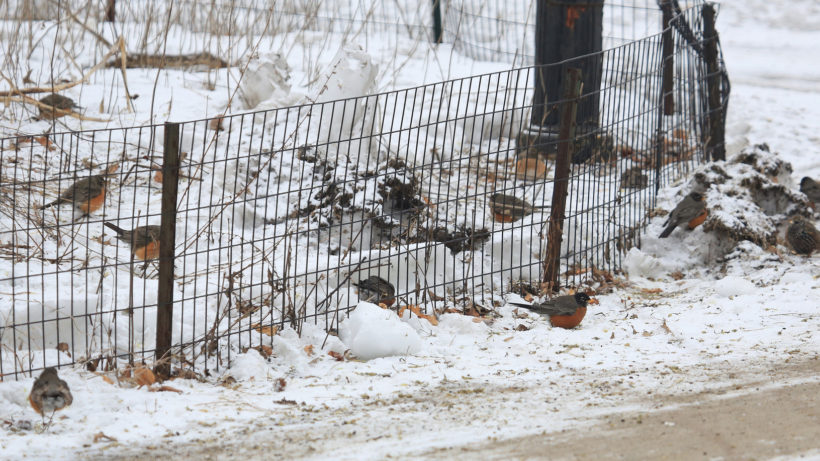
“In the wintertime robins are actually social,” Howard says. “They form flocks — all those eyes and ears are good for watching out for predators. And one of the beauties of flocking is that if one of them finds some food, it can call the rest.”
Even in freezing temperatures, robins can stay warm enough to make staying through the winter worthwhile. Those who remain near their mating grounds will get first dibs on the best nesting territories when spring arrives.
“Sometimes you see them and it’s so cold you think, ‘My goodness they’ll all die.’” Howard says. “It’s amazing, the way they survive winter is they fluff their feathers and get really big. Their internal temperature is 104° F and yet they can be in areas below freezing. That’s how well their feathers insulate them; there can even be a 100-degree difference just through those layers of feathers.”
If you want to observe robins in winter, try putting out water for them. They can survive on their own by eating snow, but birds always welcome a source of unfrozen water for drinking and bathing.
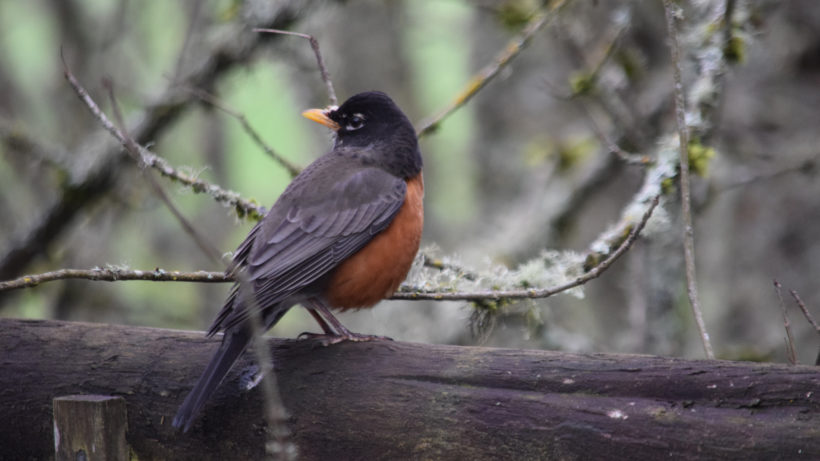
The First Robin of Spring
Robins haven’t been entirely dethroned from their poetic status as spring symbol. Though notions of spring vary by region and temperature. Some robin behaviors take place in step with the warming temperatures that people associate with the arrival of spring.
For instance, as temperatures warm in springtime, the bulk of the robin population follows a more reliable northward spring migration pattern.
“In the spring they migrate with a 36-degree isotherm,” Howard explains. “The ground thaws and that’s when traditional earthworms and some other insect larvae are available. That’s when you see big movements.”
More than anything, the robin’s song remains a reliable indicator that the first wave of spring migration has reached you. This song is one of the first signs that robins are switching from winter behavior to courtship and nesting behavior associated with spring.
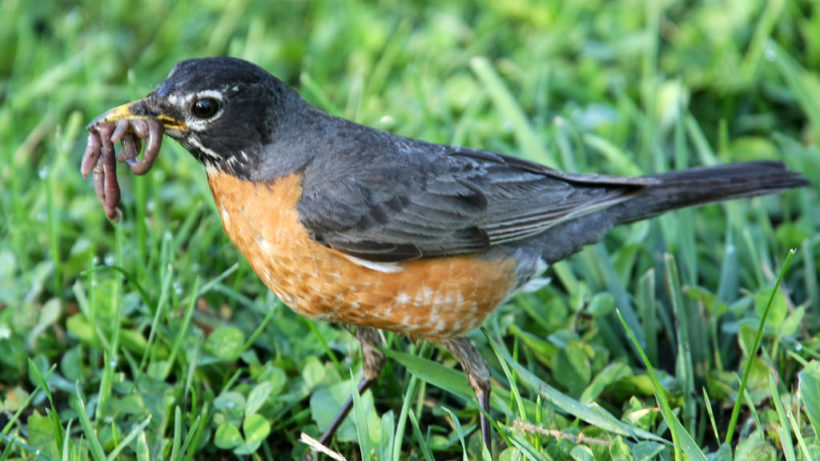
“We see a clear south to north progression in reports of territorial song,” Howard notes. “Across the continent, as males arrive on territory they begin to sing. That true robin song that you hear nonstop all day or certainly through the morning means your local male has arrived.”
Males arrive first to establish their territories – they will fight with their feet to defend them. In spring the males become so territorial that they’ve been known to beat themselves up while trying to fight their own reflection.
“Females arrive a couple of weeks later,” Howard says. “They’re not in a rush. Their job is to have fat stores as plentiful as possible. They don’t want to burn through calories by migrating too early. They need to be in good condition.”
Arriving too early can be bad for reproduction too. A spring freeze can damage the integrity of the nest.
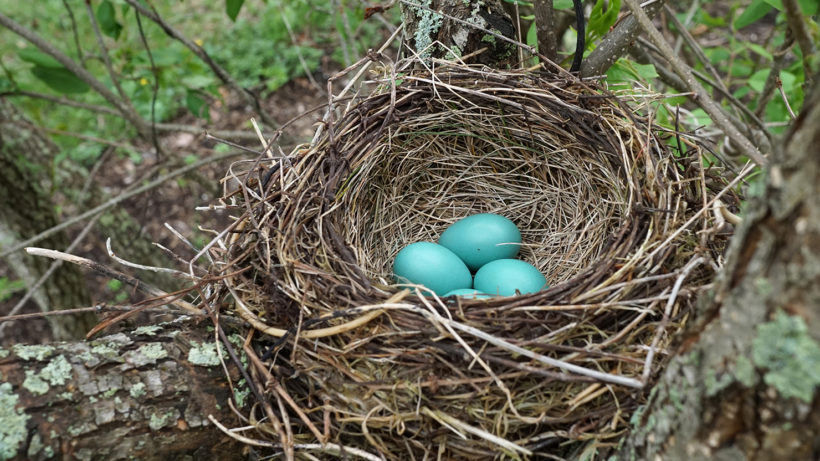
Only the females have a brood patch, an area of warm featherless skin that’s used to transfer body heat to the eggs. Females spend about 50 minutes of every hour on the nest during incubation. It’s two weeks from egg laying to hatching and robins will start a new nest within the month. Robins nest as many as four times each summer, depending on how far north they are.
As in winter, water is one of the best ways to attract robins to your yard in spring.
“If you turn on a sprinkler you’ll have robins within minutes,” Howard says. “It makes the soil soft and earthworms and other food easy to collect.”
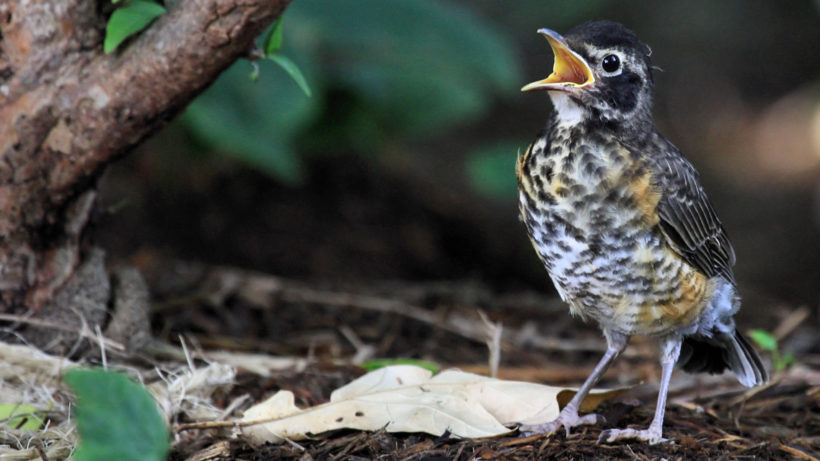
Report Your Robin Observations
You can report robin observations to Journey North all year round. As spring approaches, Journey North has a checklist of robin life cycle events to track and report:
- Over-wintering robins – watch for flocks.
- First male robin – you will know it is a male by his bold red breast and his dark head and back.
- First wave of robins – three or more robins together (but not in the winter) is a sign that migration is peaking.
- Average temperature reaches 36° F – help Journey North find out whether or not this is truly when robins sing.
- First earthworm – help Journey North find out if robin arrival is tied to earthworm availability.
- First robin song – listen for the robin’s true song.
- First female robin – she will look washed out compared to the male.
- First males in battle – they will be fighting over territories.
- Nest building begins – watch for males with a mouthful of nest materials or females with muddy breasts.
- Incubation underway – if you’re not seeing the female around anymore, she’s probably busy incubating.
- Young hatch – watch for adults flying with worms.
- First young fledge – fledglings don’t fly and have a spotted breast. You might see them on the ground or in low branches.
- First young take wing – within a few days of fledging watch for the juveniles to start their practice flights.
- Parents start another nest – when you see the male feeding the fledglings, but the female is absent, she has likely disappeared to incubate a new set of eggs.
“One of the great things about robins is they’re so accessible,” Howard says. “You can look out your window and see them. There’s so much to learn about such an unsung hero.”
Have you noticed unusual robin behavior in your neighborhood or? Share it in the comments and report your sightings to Journey North.
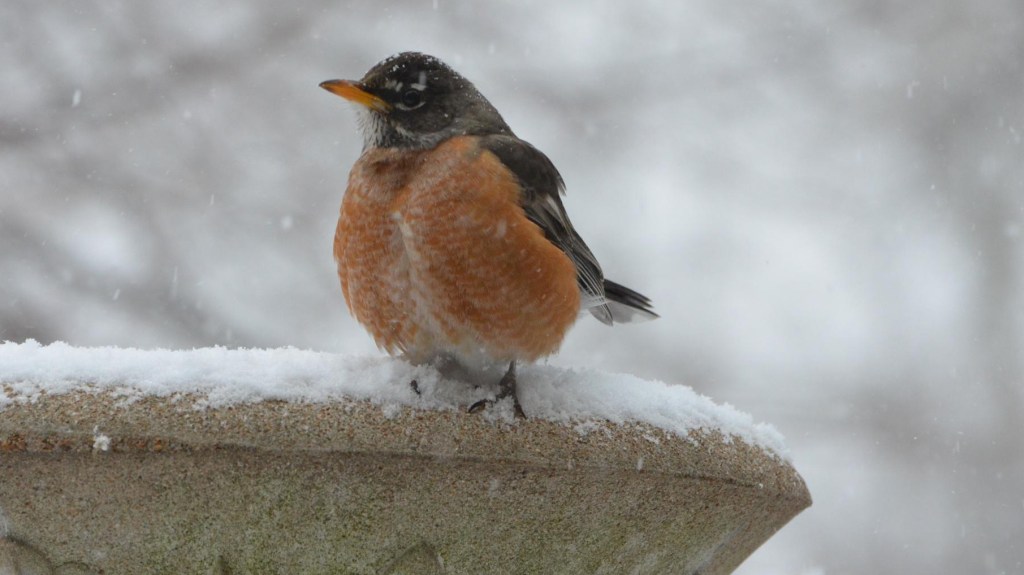



Hi!
I just saw a male robin (I think) come to our deck. He then flew and brought back two immature robins to drink from the snow melting on the black deck rubber. It is February 28th. I am surprised they nested so early. However, we did just have 2 very warm spots this January. I started seeing a very large flock about a month ago in the field on one of those warmer days after snow melted. It looked like almost 50 robins. This farm is on the South Coast of Massachusetts.
It is feb 24 and 33 degrees today with a wind chill feel of 25. There are 20 robins in my front tree, another 20 in my backyard maple, at least 20 to 30 in my.neighbors yard and an unknown amount in my giant holly tree. I live in Lyndhurst New Jersey. Never seen so many robins together like this before
Just seeing a whole flock of Robins in my yard here in Maryland. It’s like an invasion. So cool to see.
Location: Montvale, New Jersey
Date: February 16, 2022
Have been watching a swarm of robins on the ground and in the trees this morning. The temperature has been sub-freezing these last three days, but a warming trend is supposed to start this afternoon. There are no fruit trees in my immediate vicinity, and the ground is still partially snow-covered. Will take it as a sign of spring, though.
Eve of Valentine’s Day 2022, Tappan NY, one evergreen, not Juniper or Cedar was alive with what looked to be 50 to 75 robins jostling for space on snow covered boughs. Soon, the tree was snowless, while all around was white after a recent clinging snow. Temps in low 20s, gusty, unpleasant. Was something to watch for an hour or so as members of flock took off, one after another in groups of 20 or 30 in different directions but mostly in southeast direction, but came back almost instantly to regroup. Or was it yet another small flock checking out the neighborhood. Earlier I’d seen a bunch hanging out around a tree with decomosing apples and on the juniper and cedar trees eating berries. ALso the 3 different hollies. Am so glad to have made a point of keeping our yard chemical free and encouraging eco-friendly flowering and foliage in shrubs and trees & by allowing a natural small wetland to flourish.
I always have Robins in February here in Lewiston. They like our crabapple tree’s berries. They just arrived today, a flock of 20-30 and are hanging with the European Starlings.
2/8/2022
A large flock of robins (30-40) appeared in Ithaca NY three days ago and they seem to be sticking around. I assume they were all males. I’ll go for a walk and look for them again today.
Just came home today to find a big flock of robins in my backyard I was so amazed I’ve never seen it before probably over 60 mostly males I think maybe I have a lot of mud in my backyard and tire tracks that I’ve gathered water from the melted snow maybe that’s it it’s still beautiful to see no matter why they’re here I hope some of them stay
We have been seeing robins up here in Vermont this past week (January 30 – February 6). It has been very cold; 10 to 15 degrees below zero at night and about 15 derees in the day time. We also had 2 days of snowstorm totaling about 15 inches in depth. I first spotted the birds downtown around a snowbank and some small fruit trees. The birds were active and yet not eating. They seemed to be jumping and fluttering about. I think there was about 10-12 birds moving about. Today, February 6th, I saw more in our front yard . They were in our large fruit trees but did not come to our feeders hanging from the same trees. They did not come to the feeders near our house either. There were about 10 birds just jumping around between branches of the trees. I don’t think there was any left over fruit (small cherries) on the trees, but maybe a little though. They stayed for about 15 minutes and left. They also stayed quite separate from the other smaller song bird who were feeding on the feeders. It would be my guess that these were males looking for food and when they found only a little, they left. I was overall surprised to see them in such a cold spell. We live in Poultney, Vermont which is located near the New York border just south ofa frozen Lake Champlain. Thanks, Tom
Had a flock of robins invade my yard yesterday. The temperature in Reading, PA was 21 degrees. They seemed to arrive with a flock of starlings…must have been 30 Robins and more than 100 Starlings. Is this due to the winter storm bringing them from the south. We are in a cold spell right now.
Sure, was wonderful to see 4 Robins bathing in our heated bird bath. The heating element has brought lots of birds to our yard. In the 2 hours the robins and starlings were here we also saw a variety of birds.
There were woodpeckers (Hairy, red bellied, Downy), blue jays, Junco’s, Mockingbirds, House Finches, Cardinals male and female, Tufted Titmouse, Carolina wren, as well as sparrows. They cleaned out our suet and black oil sunflower feeders. Is this the sign of spring or do we listen to the groundhog?